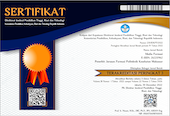Formulasi Dan Stabilitas Fisik Sediaan Lip Balm Dari Buah Stroberi (Fragaria vesca L)
Abstract
Formulation and Physical Stability of Lip Balm from Strawberry (Fragariavesca L)
Strawberries are rich in anthocyanin compounds, anthocyanins from strawberries are the main content of polyphenolic compounds with high antioxidant effects, so a formula that is more practical to use, more durable and effective, is one of the lip balm preparations. This study aims to formulate lip balm from strawberries (Fragaria vesca l) with various combination of emulsifier tween 80 and span 80: 5% w/v, 7.5% w/v and 10% w/v and to determine the physical quality of the emulsifier. the lip balm preparation. Strawberry juice is extracted by means of a juicer without being concentrated, lip balm formulation test with additives and physical quality tests were done before and after the accelerated stability test including organoleptic, homogeneity test, pH test and melting temperature test. The results showed that strawberry juice could be formulated into lip balm dosage forms with various concentrations of emulsifier tween 80 and span 80: 5% w/v, 7.5% w/v and 10% w/v with qualified physical skills. For the organoleptic test, the three formulas only showed a color change after the stability test, while in the pH test the preparations showed differences after the stability test, namely 6.3: 6.4 and 62 to 6.2: 6.3 and 6.2 respectively for the formula 1, II and III. The stability test for the melting temperature was also the same, where the lipbalm formulas I, II and II with melting temperatures of 53, 54 and 55 minutes became 54,55 and 54 minutes, respectively. While in the homogeneity test there was no visible change after the accelerated stability test. At a concentration of 10% w/v emulsifier lip balm preparation from strawberry juice has the best physical quality stability where there is no significant difference in the results of the study before and after accelerated storage (p < 0.05). Keywords : Strawberry Fruit, Lip Balm, Tween 80 and Span 80
Buah stroberi kaya akan senyawa antosianin, dengan kandungan utama senyawa polifenol dengan khasiat antioksidan yang tinggi yang berpotensi dikembangkan sebagai sediaan yang lebih mudah digunakan, lebih stabil dan efektif dalam penyimpanan, seperti sediaan lip balm. Tujuan penelitian untuk memformulasikan sediaan lip balm dari buah stroberi (Fragaria vesca l) dengan variasi kombinasi emulgator tween 80 dan span 80: 5% b/v, 7,5% b/v dan 10% b/v dan untuk mengetahui mutu fisik dari sediaan lip balm tersebut. Buah stroberi diambil sarinya dengan cara dijuicer tanpa dipekatkan, formulasi lip balm dengan bahan tambahan dan pengujian mutu fisik dilakukan sebelum dan setelah uji kestabilan dipercepat meliputi uji organoleptik, uji homogenitas, uji pH dan uji suhu lebur. Hasil penelitian menunjukkan sari buah stroberi dapat diformulasikan ke dalam bentuk sediaan lip balm dengan variasi konsentrasi emulgator tween 80 dan span 80: 5% b/v, 7,5% b/v dan 10% b/v dengan stabilitas mutu fisik yang memenuhi syarat. Untuk uji organoleptis ketiga formula hanya memperlihatkan perubahan warna setelah uji stabilitas, sedangkan pada uji pH sediaan menunjukkan perbedaan setelah uji stabilitas yaitu 6,3: 6,4 dan 6,2 menjadi 6,2: 6,3 dan 6,2 berturut-turut untuk formula 1, II dan III. Pengujian kestabilan untuk suhu lebur juga demikian , dimana lip balm formula I, II dan II dengan suhu lebur 53, 54 dan 55 menit menjadi 54,55 dan 54 menit berturut-turut. Sedangkan pada uji homogenitas tidak ada perubahan yang tampak setelah uji kestabilan dipercepat. Pada konsentrasi emulgator 10% b/v sediaan lip balm dari sari buah stroberi memiliki kestabilan mutu fisik yang paling baik dimana tidak ada perbedaan signifikan pada hasil penelitian sebelum dan sesudah penyimpanan dipercepat (p< 0,05)
Kata kunci : Buah Stroberi, Lip Balm, Tween 80 dan Span 80
Full Text:
PDF (Bahasa Indonesia)References
Departemen Kesehatan Republik Indonesia (DepKes). 1979. Farmakope IndonesiaEdisi Ketiga. Jakarta.
Draelos, Z.D., (2011). Cosmetics and Dermatologic Problems and Solutions, 3rd Ed. CRC Press. Boca Raton.
Kwunsiriwong, S. (2016). The Study on the Development and Processing Transfer of Lip Balm Products from Virgin Coconut Oil: A Case Study. The Asian Conference on Sustainability, Energy & the Environment, 1–5.
Luo, Y., Tang, H., & Zhang, Y. (2011). Production of Reactive Oxygen Species and Antioxidant Metabolism about Strawberry Leaves to Low Temperatures. Journal of Agricultural Science, 3(2), 89–96. https://doi.org/10.5539/jas.v3n2p89
Molyneux, P. (2004). The Use of the Stable Free Radical Diphenylpicryl-hydrazyl (DPPH) for Estimating Antioxidant Activity. Songklanakarin Journal of Science and Technology, 26(December 2003), 211–219. https://doi.org/10.1287/isre.6.2.144
Nowak, R. (2006). Determination of ellagic acid in pseudofruits of some species of roses. Acta Poloniae Pharmaceutica - Drug Research, 63(4), 289–292.
Ratih, H., Hartyana, T., & Puri, R. C. (2014). Formulasi Sediaan Lipbalm Minyak Bunga Kenanga (Cananga oil) sebagai Emolien. Prosiding Simpoisum Penelitian Bahan Obat Alami (SPBOA), 2(1), 34–40.
Supriadi, H. 2015. “Pengaruh Penambahan Nanopartikel ZNO dan Kalium Sorbat pada Edible Coating Karagenan dalam Mempertahankan Kesegaran Buah Stroberi (Fragaria sp.) Segar”. Skripsi. Fakultas Teknologi Pertanian IPB, Bogor.
DOI: https://doi.org/10.32382/mf.v17i2.2298
Refbacks
- There are currently no refbacks.

This work is licensed under a Creative Commons Attribution-NonCommercial-ShareAlike 4.0 International License.
Kontak Editor
Hendra Stevani
Jurusan Farmasi Poltekkes kemenkes Makassar
email : hendra@poltekkes-mks.ac.id

This work is licensed under a Creative Commons Attribution-ShareAlike 4.0 International License.




.png)


